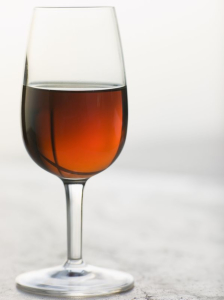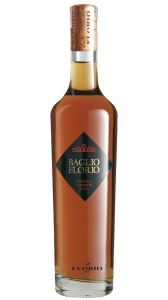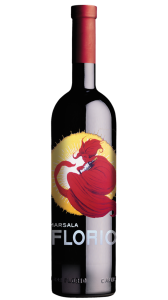 The Marsala is the oldest Italian DOC wine, with an average alcohol content of about 18 degrees. The aromatic and sugary richness of the grapes of Marsala is born from the method of growing them in a ‘sapling’ style, a very ancient method, dating back to the culture of vine itself. The vineyard is placed in a small basin with a particular pruning, so developing its clusters in the lowest part of the plant, almost in contact with the ground, while its many leaves create a shadow cone, protecting them from the sun and refreshing the underlying ground. This is a special form of agriculture, ideal for the sunny climate of these lands, a traditional practice which just requires hard manual work, but gives few, but exceptional grapes for the most important Marsala.
The Marsala is the oldest Italian DOC wine, with an average alcohol content of about 18 degrees. The aromatic and sugary richness of the grapes of Marsala is born from the method of growing them in a ‘sapling’ style, a very ancient method, dating back to the culture of vine itself. The vineyard is placed in a small basin with a particular pruning, so developing its clusters in the lowest part of the plant, almost in contact with the ground, while its many leaves create a shadow cone, protecting them from the sun and refreshing the underlying ground. This is a special form of agriculture, ideal for the sunny climate of these lands, a traditional practice which just requires hard manual work, but gives few, but exceptional grapes for the most important Marsala.
English by chance
 The Marsala wine owes its birth to a storm which in 1773 forced John Woodhouse, a rich and famous merchant of Liverpool, to land with his ship in the port of Marsala instead of Mazara del Vallo, where he was going to close a deal. When he landed in this Sicilian town, in order to celebrate his lucky escape, Woodhouse went into a tavern in the port, where he tasted the ‘Perpetum’, a strong local wine similar to Madeira or Porto, which were so appreciated by English people. So he decided to buy a large supply of that wine, which he wanted to sell in England. However, at that time the wine transport by sea involved serious problems regarding conservation. Woodhouse added an amount of alcohol to those barrels of wine, so increasing the alcohol content of that wine and ensuring its preservation up to its destination. The first expedition was an incredible success. All the barrels were sold in a few days and this convinced Woodhouse to return permanently to Sicily in order to develop a new and stable business. At the end of the 18th century, the Marsala wine was habitually drunk on all Her Majesty’s ships. Admiral Nelson, too, used to celebrate his victories with Woodhouse’s Marsala wine and, just after the naval battle of Trafalgar, the Marsala began to be proposed as a ‘wine of victory’. Only in 1832 we finally find an Italian name among the manufacturers of Marsala, Vincenzo Florio, who still today is one of the leading and best-known manufacturers of this valuable wine.
The Marsala wine owes its birth to a storm which in 1773 forced John Woodhouse, a rich and famous merchant of Liverpool, to land with his ship in the port of Marsala instead of Mazara del Vallo, where he was going to close a deal. When he landed in this Sicilian town, in order to celebrate his lucky escape, Woodhouse went into a tavern in the port, where he tasted the ‘Perpetum’, a strong local wine similar to Madeira or Porto, which were so appreciated by English people. So he decided to buy a large supply of that wine, which he wanted to sell in England. However, at that time the wine transport by sea involved serious problems regarding conservation. Woodhouse added an amount of alcohol to those barrels of wine, so increasing the alcohol content of that wine and ensuring its preservation up to its destination. The first expedition was an incredible success. All the barrels were sold in a few days and this convinced Woodhouse to return permanently to Sicily in order to develop a new and stable business. At the end of the 18th century, the Marsala wine was habitually drunk on all Her Majesty’s ships. Admiral Nelson, too, used to celebrate his victories with Woodhouse’s Marsala wine and, just after the naval battle of Trafalgar, the Marsala began to be proposed as a ‘wine of victory’. Only in 1832 we finally find an Italian name among the manufacturers of Marsala, Vincenzo Florio, who still today is one of the leading and best-known manufacturers of this valuable wine.
Different types
The Marsala wine has different types of productions, born by both trial and on the base of demands coming from the market, especially the foreign one. Either grape vines ‘Grillo’, ‘Catarratto’, ‘Insolia’, and ‘Damaschino’ are used, or such black grape varieties as ‘Pignatello’, ‘Nero d' Avola’, and ‘Nerello Mascalese’. After being selected, the grapes are pressed. Their must starts the fermentation, after which a strong base and full-bodied wine is obtained. Then, vinous alcohol or highest quality brandy are added, which increases the gradation. Thus the ‘Marsala Vergine’ is obtained, which must be aged in barrels of oak for at least 5 years, while in order to get the name ‘Riserva’ or ‘Stravecchio’, it cannot age for less than ten years.
Another type of Marsala wine is the one to which ‘mistella’ is added, an unfermented must which offers both sugars and scents of a rare and unique complexity. If necessary, cooked must is added, which allows obtaining smooth flavour and amber colour.
 Export
Export
The grapes selected for becoming Marsala wine are very sensitive to even small climatic changes. Sugar content, alcoholic strength, variations in colour and scents, are changed by rain, sun, more or less strong wind. This production follows rigorous protocols and for this reason it can considerably vary from year to year, going from hl 50,000 up to years in which over hl 100,000 are produced. Almost half of the whole production is for foreign markets, United States first of all, then England, Germany, and France. For some years Japan, Scandinavia, and Russia have been the new customers of Marsala.
Colonial and vintage
The image of the marsala wine in the world, refined and elegant, goes through its labels and the highest quality glass, for showing its ever-changing hues. Communicate the Marsala wine through its packaging is a primary goal of the companies which constitute the Consortium. Their great attention is shown by means of seminars, special training, research with the best designer. The Marsala wine labels are linked to the history of British trade in the Mediterranean, which introduced this product in the world. So their style is very British, elegant and functional at the same time. In addition to this style, the vintage one is very present, because just in the 20s, the Marsala wine, which was an import product in England, became a cult wine world.
